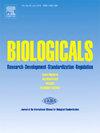Zamerovimab和Mazorelvimab单克隆抗体与HRIG在III类狂犬病暴露后预防中的药代动力学和安全性比较:伤口特征的分层分析
IF 1.5
4区 生物学
Q4 BIOCHEMICAL RESEARCH METHODS
引用次数: 0
摘要
目的比较Zamerovimab和Mazorelvimab单克隆抗体(maabs)与人狂犬病免疫球蛋白(HRIG)在III类异质伤口暴露患者中的狂犬病病毒中和抗体(RVNA)动力学和安全性。方法在这项随机、双盲、III期试验中,1000名III类暴露者被分为单伤口组(n = 735)和多伤口组(n = 265)。受试者在第0天接种0.3 mg/kg单克隆抗体(n = 750)或20 IU/kg HRIG (n = 250),随后接种Essen方案疫苗。在第0、3、7、14和42天,通过快速荧光病灶抑制试验(RFFIT)定量RVNA水平。主要终点包括RVNA几何平均浓度(GMC)、血清转化率(RVNA≥0.5 IU/mL)和不良事件发生率(ae)。结果单克隆抗体处理亚组在早期时间点(例如,第3天,单伤口亚组:4.552 vs. 0.297 IU/mL;多伤口亚组:4.06 vs. 0.305 IU/mL),到第3天达到99.8%以上的血清转化率。与单伤口亚组相比,多伤口亚组的单克隆抗体血清RVNA转化率相似或更高,而HRIG的血清阳性率较低。在单伤口和多伤口亚组中,不良反应在HRIG受者中更为常见(单抗:41.9%,42.4%;Hrig: 55.3%, 54.8%)。HRIG组治疗相关ae也较高(单抗:26.3%,27.1%;HRIG: 39.9%, 48.4%),尤其是多伤亚组。大多数局部和全身ae的严重程度为轻至中度。在365天的研究期间,没有发生疑似狂犬病病例或死亡,也没有参与者因不良反应退出研究。结论与HRIG相比,zamerovimab和Mazorelvimab在不同伤口类型中获得的RVNA滴度更早、更高,且安全性相当。在多伤口暴露中,与HRIG相比,单克隆抗体治疗显示出更高的RVNA血清转换率和更低的反应原性,为其优先用于高风险狂犬病暴露提供了强有力的证据。本文章由计算机程序翻译,如有差异,请以英文原文为准。
The pharmacokinetics and safety comparison of Zamerovimab and Mazorelvimab monoclonal antibodies vs. HRIG in category III rabies post-exposure prophylaxis: a stratified analysis by wound characteristics
Objective
To compare rabies virus neutralizing antibody (RVNA) kinetics and safety profiles of Zamerovimab and Mazorelvimab monoclonal antibodies (mAbs) versus human rabies immunoglobulin (HRIG) in Category III rabies-exposed patients with heterogeneous wound characteristics.
Methods
In this randomized, double-blind, phase III trial, 1000 participants with Category III exposure were stratified into single-wound (n = 735) and multi-wound (n = 265) subgroups. Subjects received either 0.3 mg/kg mAbs (n = 750) or 20 IU/kg HRIG (n = 250) on Day 0, followed by Essen regimen vaccination. RVNA levels were quantified by Rapid Fluorescent Foci Inhibition Test (RFFIT) at 0, 3, 7, 14, and 42 days. Primary endpoints included RVNA geometric mean concentration (GMC), seroconversion rate (RVNA ≥0.5 IU/mL) and incidence of adverse events (AEs).
Results
The mAbs-treated subgroups exhibited significantly higher RVNA GMCs than HRIG at early timepoints (e.g., Day 3, single-wound subgroups: 4.552 vs. 0.297 IU/mL; multi-wound subgroups: 4.06 vs. 0.305 IU/mL), achieving over 99.8 % seroconversion by Day 3. The mAbs showed similar or higher RVNA seroconversion rates in multi-wound subgroup compared to single-wound subgroup, while HRIG exhibited lower serum positivity rates. AEs were more common in HRIG recipients across both single-wound and multi-wound subgroups (mAbs: 41.9 %, 42.4 %; HRIG: 55.3 %, 54.8 %). Treatment-related AEs were also higher in HRIG groups (mAbs: 26.3 %, 27.1 %; HRIG: 39.9 %, 48.4 %), particularly in multi-wound subgroups. Most local and systemic AEs were mild to moderate in severity. No suspected rabies cases or deaths occurred through the 365-day study period, and no participants withdrew due to AEs.
Conclusion
Zamerovimab and Mazorelvimab achieves earlier and higher RVNA titers than HRIG across diverse wound types, with comparable safety. In multi-wound exposures, mAbs therapy demonstrates superior RVNA seroconversion rate and reduced reactogenicity compared to HRIG, providing robust evidence for its preferential use in high-risk rabies exposures.
Registration
ClinicalTrials.gov #NCT04644484.
求助全文
通过发布文献求助,成功后即可免费获取论文全文。
去求助
来源期刊

Biologicals
生物-生化研究方法
CiteScore
3.70
自引率
0.00%
发文量
39
审稿时长
48 days
期刊介绍:
Biologicals provides a modern and multidisciplinary international forum for news, debate, and original research on all aspects of biologicals used in human and veterinary medicine. The journal publishes original papers, reviews, and letters relevant to the development, production, quality control, and standardization of biological derived from both novel and established biotechnologies. Special issues are produced to reflect topics of particular international interest and concern.Three types of papers are welcome: original research reports, short papers, and review articles. The journal will also publish comments and letters to the editor, book reviews, meeting reports and information on regulatory issues.
 求助内容:
求助内容: 应助结果提醒方式:
应助结果提醒方式:


